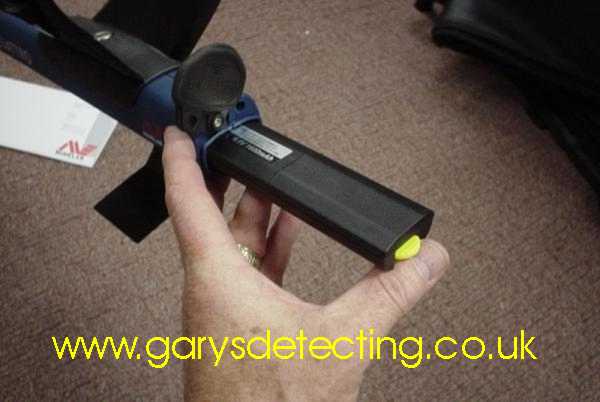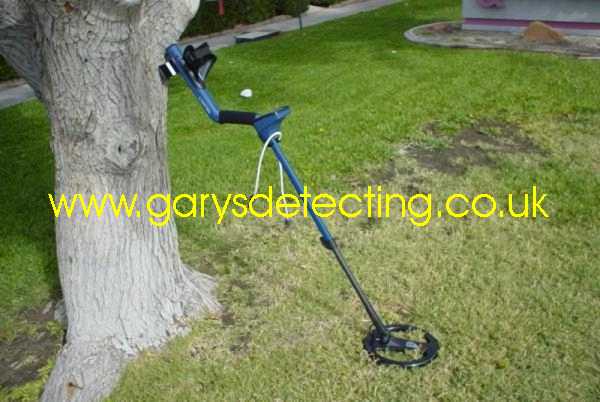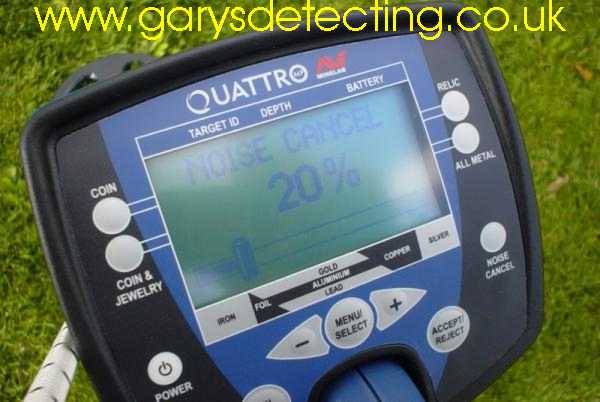Garys Detecting.co.uk
Minelab Quattro honest field test by Gary's detecting
Introducing the Minelab
Quattro
Here we have the Minelab Quattro, originally released as a simpler version
of the Explorer, it uses the same box, stem and coil as the Explorer so
naturally it is the same weight. Operating between 12Khz and 16Khz depending on
what chanel the automatic noise cancel chooses for optimum performance.
The Quattro still utelises the superior Minelab Iron and hot rock rejection.
The real changes are in the operation and the software, easier yes but less
performance I don't think so.
Once powered up the Quattro is self explanatory, hit the menu button which then
allows you to access 6 simple features
Features
Sensitivity 1 to
20 then auto position
Threshold 1 to 20
noise cancel 1 to 10 the Quattro will automatically
choose the best channel.
Volume Adjusts the
target volume to suit the operator
Contrast Adjusts
the screen contrast for best viewing
Trash Density A nifty little button for a faster response in junky
conditions |
Once adjusted to your personal preference just hit the pin point button to
return to the detect mode.
These 6 settings are on a "hot" key so by simply pressing the menu button again
it will take you directly to the last feature you adjusted.
Search modes
Coins To much rejection for European conditions
Coin and jewelry Less rejection
than coins but still to much
Relic Ok for
coinshooting, more of a novice setting
All Metal Optimum
performance combined with sensitivty/trash density |
The tone ID is the same as the Explorer and can not be set to
single tone which may not please some people, however there is an option to switch between
Ferrous and Conductive audio by choosing.
Coins and Coin & Jewelry...uses the conductive audio which uses the
conductivity to determine the audio pitch of the signal.
Relic & All metal.....uses the ferrous audio which uses the Iron content
to determine the audio pitch of the signal.
The discrimination segments are quite narrow which is better for UK conditions,
Each pre-set discrimination program can be modified by the operator and saved in
4 empty locations.
Trash density button..Low or High
Low is for general searching in uncontaminated soil, meter readings will be at
their best and the machine will perform smoothly.
High turns the machine from little bo peep to Artilla the Hun it
becomes very sparky and works a lot harder for you, recovery speed is faster,
iron rejection and meter readings become less reliable. It is a much better
setting for junky conditions but be prepared to dig a little Iron, some good
targets will register
as low as -3, Iron can give high plus numbers if the sensitivity is to high.
First test on the Roman field
My first outing was to my very badly Iron contaminated Roman field where
Minelabs have never worked well and the Quattro was really no different, I tried
every possible setting and configuration even with the 8" coil but I only
managed a handful of good targets the maximum sensitivity without erratic
operation I could use was 10.
The 8 AA batteries ran down after 5 hours solid detecting. Although slightly
disappointed I was not surprised with the overall finds and performance as
the field has been hammered for years and now very hard to search, most of the easy finds have been found
leaving a carpet of Iron.
I
enjoyed using the Quattro, it's features will be more than adequate for most
European search conditions, although I personaly feel the slower processor speed
of the Minelab can not compete with the fast recovering high frequency machines in this type of
badly iron contaminated soil.
Iron + Mineralisation = Habitation
Habitation + Fast Recovering Machine = Finds
Pasture field
This field is low in mineralisation the Explorers and Sovereigns have done well in the past, 8
inches of baron soil and then a hard packed gravel layer where all the goodies
are located.
The Quattro sensitivity could be turned up to the maximum 20 in "All metal" and still had a
stable threshold it wasn't long before I got a high pitched signal with a very
low indication on the depth gauge I called Steve over to check the signal but he
had nothing, 10" down in the gravel layer came up a slightly battered Lizzy
sixpence dated 1594. I found some other deep copper coins during the search, my confidence had been restored.
Back to the Roman field
I went back to my original field to try the Quattro again with Tony and Barry,
having talked to some other users in the States. I now had a couple of tricks up my sleeve and a
new theory of my own.
Running the Quattro in all metal with the trash density set to low calmed the
machine enough to pick out the tiny low tones in amongst the high Iron squeeks.
Once the target was located the coil could be worked in short passes to produce a more solid sound. I dug some
very difficult targets using this method.
Tip
If I had to use a Quattro on a bad site I
would use it in all metal "conductive" ignore the high sounds
and listen for the low tone's...In most cases small deep targets will
give a low tone sometimes with a meter reading as low as -3 or -4..simply lock
on to the centre of the signal by tight passes of the coil and be prepared to
investigate.
Is the Quattro a simpler version
of the Explorer ?
No I think it is a completely different machine altogether,
in fact I like the Quattro package better.
I felt more in control with this machine, the performance was no less than
the Explorer, agreed less features but good old fashion simplicity.
Summary
Yes I like this one, I think if you can get the power up past 16 without
falsing you will have a good day with the Minelab Quattro....Oh and always take
along some spare batteries.
If you want to get the verrrry best out of your Quattro it would be wise to run it in all
metal, as a last resort reject only -10, I have found running any higher rejection
can cut performance drastically in bad soil.
Meter Identification
Sadly the Quattro fails to identify targets accurately at depth it is the same as most
other meter id machines.
You can not trust what it is telling you on the screen, it is best to treat the
meter as an added bonus and listen to the tones for better ferrous and
non ferrous identification.
There are 2 types of all metal with the Quattro
|
1. First option simply press the all metal
button and search...this will activate the
ferrous audio giving a low tone for Iron and higher tones depending
on the non ferrous quality of targets. This method is OK for bigger
targets but does not suit my style of detecting.
Low tone ....low numbers -3 to -10 will
be Iron
Higher Tone's good numbers -3 upwards will be
good targets
Disadvantage....Some deep Iron will also give a high tone especially when
running a higher sensitivity with Trash density on, can be confusing
if searching a contaminated site. |
|
2. Second option..my preferred method
press the coin and jewelry button activating the "conductive audio" then
with the cursor accept every number, only reject -10. Iron will now give a high tone and low conductivity
targets such as small Roman and Hammered coins will give a very distinctive low
grumble which is very easy to identify.
Disadvantage.... Iron will give a High tone but so will large Items such
as copper and large silver coins, keep your eye on the meter remember
High tone and
high numbers...Good target
High tone and low numbers....bad target Iron. |
I hope this helps anyone who is new to the Quattro, I would like to say thanks
to Des Dunne for his advice.
The Minelab Quatro is very easy to assemble


Insert the battery

Ready to go

The on-board display with target identification

This metal detector has some very nice features,target ID,depth indicator,relic
or coin mode.

Explorer coils and accessories
are compatable with the quatrro
Now for the technical stuff







